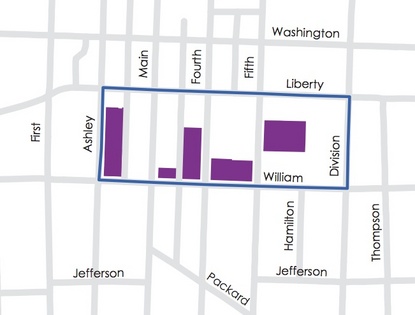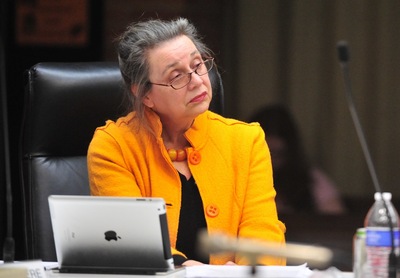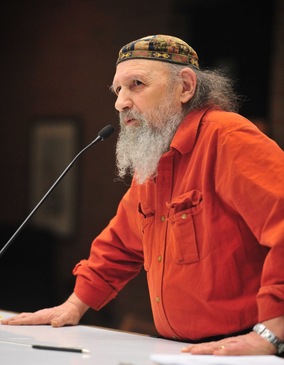The Ann Arbor Planning Commission voted unanimously Tuesday night to make the Connecting William Street plan an official city planning document.
As a resource document supporting the city's Master Plan, the lengthy report produced by the Downtown Development Authority and its consultants, which recommends strategies for improving the William Street corridor and redeveloping five city-owned properties downtown, is now among the official documents city planners will rely on in the course of their work.
"As staff, we would reference that when we provide our staff recommendations to you," Wendy Rampson, the city's planning manager, told commissioners. "As we meet with developers or others who might be interested in a site, it would be something that we bring forward."

A map of the Connecting William Street study area and the five city-owned properties recommended for redevelopment.
Ann Arbor DDA
"In reviewing the Connecting William Street plan, planning staff feels there is a lot of very valuable information in that plan that supports not just the development or potential development of these five sites, but also development throughout the downtown," she said.
But in a matter of minutes after the vote Tuesday night, after a handful of citizens objected and called the commission's action "regrettable" and "potentially dangerous," Commissioner Wendy Woods had a change of heart and called for a reconsideration.
Sabra Briere, who serves on both the City Council and Planning Commission, joined Woods, suggesting Tuesday's public hearing on the plan wasn't well publicized by the city and she wanted to give more residents an opportunity to chime in before a final decision was made.
"I'm really concerned that we're accepting this document as a reference point for future planning, primarily because the council as a whole really was, at best, lukewarm to it," Briere said. "I'm not certain that I could go back to the council and get their agreement that this should be used as a document for reference for this body, and I'd like to be able to do that."
Briere and Woods were outnumbered, though. Chairman Kirk Westphal, who served on the committee that helped craft the plan, said he felt comfortable with the public process that took place over the last year, and the other commissioners sided with him.
The City Council in April 2011 directed the DDA to take responsibility for facilitating a new process for redeveloping five city-owned properties, including the Library Lot on Fifth Avenue, the Y Lot at Fifth and William, the first floor of the Fourth and William parking garage, the Palio Lot at Main and William, and the Kline Lot at Ashley and William.

Sabra Briere said the City Council's reaction to the Connecting William Street plan was lukewarm at best.
Ryan J. Stanton | AnnArbor.com
"As we talk about this, we have to think about how much this document should govern future decisions for these sites," she said, "because the City Council may decide to sell these sites rather than plan them themselves, and that's especially true when it comes to the old Y Lot."
Tuesday night's discussion surrounding the plan — at some points contentious — lasted two and a half hours, with five residents showing up to speak out against it. Residents and even some commissioners acknowledged they weren't sure there was going to be a public hearing before Tuesday, and they guessed more people might have come to speak had they known about it.
The residents who did show up heavily criticized the DDA and its $100,000 planning process that led to the creation of the Connecting William Street plan.
Will Hathaway, a representative of the Library Green Conservancy, a grass-roots group pushing for a downtown central park on the Library Lot, said his group found the process frustrating.
"It was difficult to feel as if you were being heard or taken seriously," he said. "It seemed like the process was, in fact, preordained, like it was supposed to wind up where it did."
Hathaway and others argued it seemed the fix was in from the start for a recommendation of dense development without serious consideration given to downtown open space.
"This report is the product of a fundamentally flawed process," said Jack Eaton, a longtime community activist who wants to see more open space downtown. "The DDA is obstinate in its refusal to include parkland and open space uses as considered appropriate for these five parcels, even though there was broad public support expressed in open-ended questions for those uses."
Hathaway said he thinks the only reason there's some consideration of open space in the DDA's plan is because his group wouldn't go away.
"We had to really make ourselves a nuisance, instead of just participating, because there wasn't really a good faith effort, I feel, to welcome public input," he said.
Alan Haber, another longtime community activist, said he questioned the DDA's presumption that there should be a profit-making building on every lot.

Alan Haber, a longtime community activist, said he questioned the DDA's presumption that there should be a profit-making building on every lot.
Ryan J. Stanton | AnnArbor.com
Haber also is working with a handful of council members to put a resolution supporting the ice rink proposal on the council's March 18 agenda, and he's hopeful it will have majority support.
Amber Miller, the DDA's planning and research specialist, appeared before the commission Tuesday night to give a report on the Connecting William Street plan. Briere asked Miller to explain the DDA's recommendation for a building on every one of the five parcels.
"I think it came from the goal of wanting to increase the activity downtown and providing more space for people to have opportunities to live downtown, work downtown and engage in activities downtown," Miller said, adding the pace at which such development happens will be driven by the City Council, which ultimately gets to decide when and how to sell the properties.
Executive Director Susan Pollay said the DDA stands ready to help the City Council wherever it sees the next phase going.
"If they choose to pursue a brokered sale of land, we're there to help," she said. "If they pursue the way we've set out, which is an RFQ/RFP, we're there to help."
In addition to residential and commercial uses, the Connecting William Street plan includes the suggestion of a cultural use such as a theater, museum, performance venue or gallery.
Commissioner Bonnie Bona said the city should have more discussion about that concept because she doesn't expect it's anything developers will take on without some incentives.
Commissioner Ken Clein, an architect by trade, wondered if there was enough room to have vibrant sidewalks along William Street if the buildings are being built right up to the property line. Miller said an expansion of the sidewalk, narrowing the street width, is contemplated.
Multiple commissioners said they think it would be beneficial to have more discussion about open space in the downtown, and they're looking forward to hearing a report back from the city's Park Advisory Commission, which is actively studying the issue right now.
Clein said he's not a proponent of a central park, but he does think there is room for more open space downtown, and he likes the DDA's idea of having it privately held and privately maintained.
"There can be nice public space amenities and open space amenities and it doesn't always have to be a huge park," he said.
Clein commented specifically on the Palio Lot, a site Mayor John Hieftje has suggested might make for a good plaza space.
"I have a concern about the D1 zoning of the property," Clein said. "If that could be built at eight stories, even at five stories, it seems to be quite a harsh change."
Commissioner Eric Mahler also chimed in on the open space debate, saying it seems the same ideas keep getting recycled.
"If we keep with the privatization of these open spaces as this recommends, I think you're going to have some real challenges in keeping it constantly active," he said.
"In my private conversation with other members of the planning staff, they've stressed to me that any open space in the downtown has to be very meticulously planned," he added, "and you're not going to get that kind of meticulous planning if it's privately owned."
The DDA's plan includes small pockets of open space mixed with new development, as well as a plaza on a corner of the Library Lot, but Woods asked why there wasn't more open space.
"It just seems like there are opportunities to really try and have some win-win scenarios," she said, giving her opinion that having small pockets of open space "just irritates people."
Pollay said the plan wasn't intended to get too granular, but rather suggest ideas that could be rendered as actual projects come forward.
Woods stressed the importance of open spaces.
"As I'm looking at these plans, they're talking about more people, more people, more people, and it's therefore incumbent upon us to find open spaces or green spaces for those folks," she said.
Bringing up the fact that the University of Michigan has been taking property off the city's tax rolls, Bona suggested the city should be careful about doing the same by creating more parkland.
"We have a flood plan that has a huge number of properties in the floodway, and if over time those actually were not built on, we're talking about a lot of city property that would no longer be taxable," she said. "One of the nice things about that is some of that is in the Allen Creek Greenway, which may be a plan we have, but I think we need to be sure we think about parkland in the whole city context."
Bona said it's easy to pick any site in Ann Arbor and say: Wouldn't it be nice if there were a park there? But she said the city can't have parkland everywhere.
Ryan J. Stanton covers government and politics for AnnArbor.com. Reach him at ryanstanton@annarbor.com or 734-623-2529. You also can follow him on Twitter or subscribe to AnnArbor.com's email newsletters.